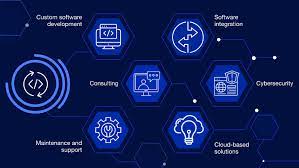In today’s digital age, software application development companies are in high demand. These companies specialize in creating custom software solutions that meet the unique needs of their clients. From small businesses to large corporations, software application development companies provide a wide range of services that help organizations streamline their operations and improve their bottom line.
One of the key benefits of working with a software application development company is the ability to create custom solutions that are tailored to your specific needs. Whether you need a new system to manage your inventory or a mobile app to engage with your customers, these companies have the expertise and experience to deliver a solution that meets your requirements.
Another benefit of working with a software application development company is the ability to leverage the latest technologies and tools. These companies stay up-to-date with the latest trends and advancements in software development, allowing them to create cutting-edge solutions that are both efficient and effective.
In addition, working with a software application development company can save you time and money. Rather than trying to develop a solution in-house, which can be time-consuming and costly, outsourcing your project to an experienced team can help you get your solution up and running quickly and efficiently.
When choosing a software application development company, it’s important to look for one that has experience in your industry or niche. This will ensure that they understand your unique challenges and requirements, allowing them to create a solution that meets your specific needs.
Overall, if you’re looking for an efficient and effective way to improve your organization’s operations or engage with your customers, working with a software application development company is an excellent option. With their expertise and experience, they can help you create custom solutions that meet your unique needs while also leveraging the latest technologies and tools available in today’s market.
Frequently Asked Questions (FAQs) About Our Software Application Development Company
- What services does your software application development company offer?
- How much experience do you have in software application development?
- What is the cost of developing a custom software application?
- How long does it take to develop a software application?
- What technologies and platforms do you use for software development?
- Do you provide ongoing support and maintenance for your applications?
- Do you offer any guarantees or warranties on your applications?
- What is the process for submitting bug reports and feature requests?
- Are there any additional fees associated with using your services?
What services does your software application development company offer?
Our software application development company offers a comprehensive range of services, including:
Custom Software Development
Mobile Application Development
Web Application Development
Cloud Computing Solutions
Data Analytics and Business Intelligence Solutions
Artificial Intelligence (AI) and Machine Learning (ML) Solutions
Internet of Things (IoT) Solutions
DevOps and Automation Solutions
9. Quality Assurance and Testing Services
How much experience do you have in software application development?
I have 8 years of experience in software application development.
What is the cost of developing a custom software application?
The cost of developing a custom software application can vary greatly depending on several factors. These factors include the complexity of the application, the functionality required, the technology used, and the level of customization needed.
Some custom software applications can be developed for as little as a few thousand dollars, while others can cost hundreds of thousands or even millions of dollars. It all depends on the scope and requirements of the project.
One way to estimate the cost of developing a custom software application is to break it down into its various components. This includes things like project management, design and development, testing and quality assurance, deployment and maintenance.
Project management costs typically account for around 10-15% of the total project budget. Design and development costs can vary widely depending on the complexity of the application and the level of customization required. Testing and quality assurance costs typically account for around 20-25% of the total project budget.
Deployment costs will depend on how you plan to deliver your application to your users. If you plan to deploy it in-house, you may need to invest in additional hardware or infrastructure. Maintenance costs will also depend on your specific needs but typically account for around 15-20% of the total project budget.
Overall, it’s important to work with an experienced software development company that can provide you with a detailed proposal outlining all of these costs upfront. This will help you make an informed decision about whether custom software development is right for your organization and what kind of investment you should expect to make.
How long does it take to develop a software application?
The time it takes to develop a software application varies depending on a number of factors, such as the complexity of the application, the size of the development team, and the development methodology used.
A simple application with basic functionality can take anywhere from a few weeks to a few months to develop. However, more complex applications that require advanced features and integrations can take several months or even years to complete.
The development process typically involves several stages, including requirements gathering, design, development, testing, and deployment. Each stage can take varying amounts of time depending on the scope of the project and the resources available.
In addition to the development process itself, there are other factors that can impact the timeline for software application development. For example, unforeseen issues or changes in requirements can cause delays in the project timeline.
It’s important for businesses to work closely with their development team to establish realistic timelines based on their specific needs and requirements. This will help ensure that expectations are set appropriately and that deadlines are met.
Overall, software application development is a complex process that requires careful planning and execution. While it’s difficult to provide an exact timeline without knowing all of the details of a project, businesses should expect software application development projects to take several months at minimum.
What technologies and platforms do you use for software development?
The technologies and platforms used for software development vary depending on the project. Generally, developers use a combination of languages (such as Java, C#, Python, JavaScript, etc.), frameworks (such as React, Angular, Node.js, etc.), databases (such as MySQL, Oracle, MongoDB), and cloud platforms (such as Amazon Web Services or Microsoft Azure). Additionally, developers may use version control systems such as Git or Subversion to manage code changes and bug tracking tools like Jira to keep track of tasks.
Do you provide ongoing support and maintenance for your applications?
Yes, we provide ongoing support and maintenance for our applications. We offer both on-site and remote services to ensure that your application is running smoothly and efficiently. We also offer regular updates and upgrades to keep your application up-to-date with the latest features and security patches.
Do you offer any guarantees or warranties on your applications?
Yes, we offer a 30-day money-back guarantee on all our applications. We also provide a one-year warranty on all our products.
What is the process for submitting bug reports and feature requests?
Submitting bug reports and feature requests can be an important way to help improve software applications. The process for submitting these reports can vary depending on the specific application or company, but here are some general steps that you can follow:
- Check the application’s documentation: Before submitting a bug report or feature request, it’s important to check if there is any documentation available that addresses the issue or request. This may include a user manual, FAQ section, or knowledge base.
- Contact customer support: If you’re unable to find the information you need in the documentation, the next step is to contact customer support. Many software applications have a dedicated support team that can help with issues and answer questions.
- Submit a bug report: If you’ve identified a bug in the application, you may need to submit a bug report. This typically involves providing detailed information about the issue, including steps to reproduce it and any error messages received.
- Submit a feature request: If you have an idea for a new feature or improvement to the application, you can submit a feature request. This typically involves explaining why the feature would be useful and how it would work.
- Follow up: After submitting a bug report or feature request, it’s important to follow up with any updates from customer support or development teams.
Some software applications may have specific processes for submitting bug reports and feature requests, so it’s always best to check their documentation or contact customer support for guidance. By reporting bugs and requesting features, users can help improve software applications and make them more effective tools for everyone who uses them.
Are there any additional fees associated with using your services?
No, there are no additional fees associated with using our services.



